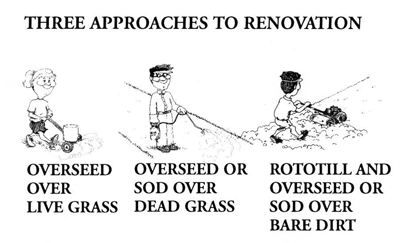Lawn renovation is all about bringing tired grass back to life. Over time, lawns thin out, weeds move in, and bare spots start to show. That’s when it’s time to think about renovation, a simple process that restores strength and color without starting from scratch. Whether you’re planning a complete lawn renovation or just freshening up patchy areas, this guide will help you choose the best approach for your yard.
Defining Renovation
A good looking lawn does not stay good looking without some upkeep from time to time. Lawns start to show their age after several years, no matter how well they are cared for. Grass plants grow tired and thin out, allowing weeds to invade the bare spots. The appearance of your yard will decline unless you take steps to restore the health and vigor of the lawn:
Routine Maintenance - The easiest way to insure a beautiful lawn for the long term is to overseed the existing turf every four or five years or when it is about 25% weeds.
Renovation – Renovation means starting the lawn over, which is virtually the same as installing it from scratch. Consider renovating lawn areas that are about 50% weeds. While it is a major undertaking, its possible to renovate a lawn that is less than a quarter acre (roughly 10,000 square feet) yourself, especially if you do only a portion each year. Larger lawns are best renovated by turf professionals.
Renovation Choices
 |
If you have an existing lawn of perennial ryegrass, tall fescue, Kentucky bluegrass or a combination of these cool weather grasses you must decide whether you want to renovate with grass seed or with sod. You must also decide whether you want to renovate the soil at the same time by tilling organic matter into it prior to seeding or sodding. With seed, a second seeding the following fall is necessary to create a satisfactory dense turf.
Seeding on dead turf is the easiest renovation technique. Kill all the weeds and grass in your lawn, mow short to prepare a seedbed, then spread new grass seed in the stubble of the dead former lawn. This method does not address the poor soil that probably caused your lawn to decline in the first place.
Seeding on bare soil is more difficult, but more beneficial over the long term. It takes much more time and work than simply seeding on top of dead turf. However, because the soil is improved, once the lawn is filled in and mature it is healthier and more self-reliant.
Choosing New Grass Seed
Regardless of which type of grass you choose, buy the highest quality seed you can find. Premium seed costs a bit more, but that is because it represents the most advanced technology in breeding. This grass will have greater disease, pest and drought resistance and the nicest appearance. These are the qualities that you want in your new lawn.
There are benefits to sowing more than one type of grass in your lawn. Every grass has its own particular set of fungal diseases to which it is susceptible. A combination (such as Kentucky bluegrass and perennial rye) significantly reduces a lawn’s vulnerability to a particular fungal disease problem. If one grass becomes diseased, the other type is resistant and keeps the lawn looking good.
Most quality grass seed packages indicate how many square feet of lawn their contents cover. Calculate the size of your lawn in terms of thousands of square feet. Purchase enough seed to meet package specifications for brand new lawns.
Conclusion
Renovating a lawn may take some time and care, but it’s one of the best ways to keep your yard lush and healthy for years. By picking the right seed, improving the soil, and following through with regular upkeep, your lawn will recover faster and stay stronger through every season.
Ready to take the next step? See our guide on spring lawn renovation to plan your timing perfectly.

